
On the Beach
As I continue in my effort to sort fact from fiction in the received versions of the production of Robert Capa’s D-Day images and their post-exposure fate, I have to conclude that we have no hard evidence that Capa made any exposures after the last of the “Magnificent Eleven” — the eleven frames that survived. And nothing proves that Capa stayed on the beach under fire and photographing for more than 40 minutes at most. (To see all of Capa’s D-Day images at the Magnum website, click here.)
Capa’s caption notes to John Morris re the films he sent to him via courier on the evening of June 6, after Capa’s return from Omaha Beach, indicate that three of the four 35mm rolls contained images he made on shipboard on the night of June 5 and the early hours of June 6. These notes appear — published for the first time, so far as I know — in “Behind the Photo: Robert Capa’s D-Day,” a brief TIME video from May 29, 2014. (My thanks to reader Mike Doukas for providing these screenshots of them, which I’ve annotated to highlight Capa’s indication that they’re 36-exposure 35mm films.)
Roll 1 consisted of images of the troops (made from the dock, from the deck, or both) of the troops boarding with their full packs and weapons:
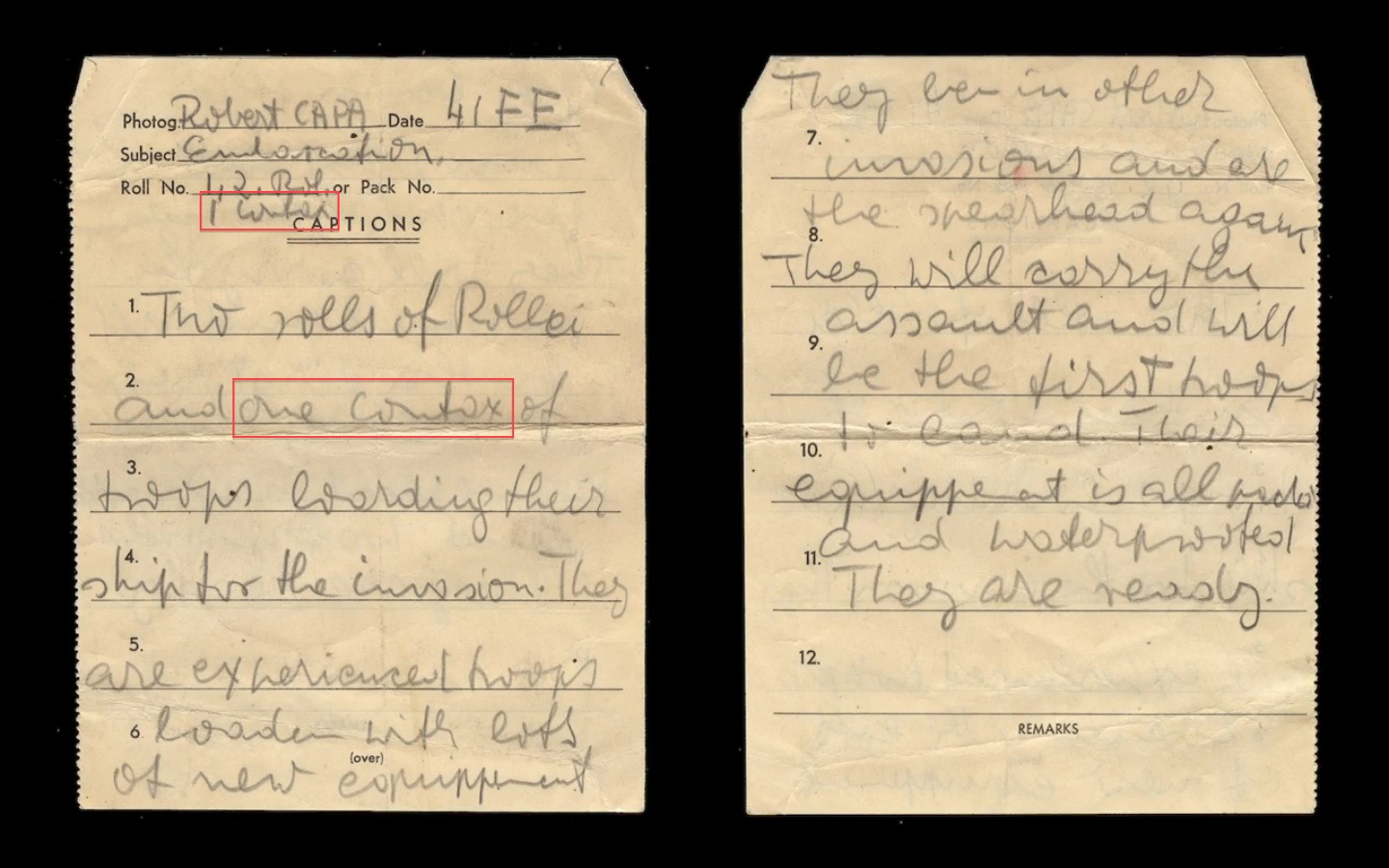
Robert Capa, D-Day image captions, Contax 35mm Roll 1, annotated.
Roll 2 contained images of the troops on deck, observing and counting the other vessles in the vast armada of which they were part, quietly interacting with each other, with their helmets and weapons (and presumably, packs) set aside:
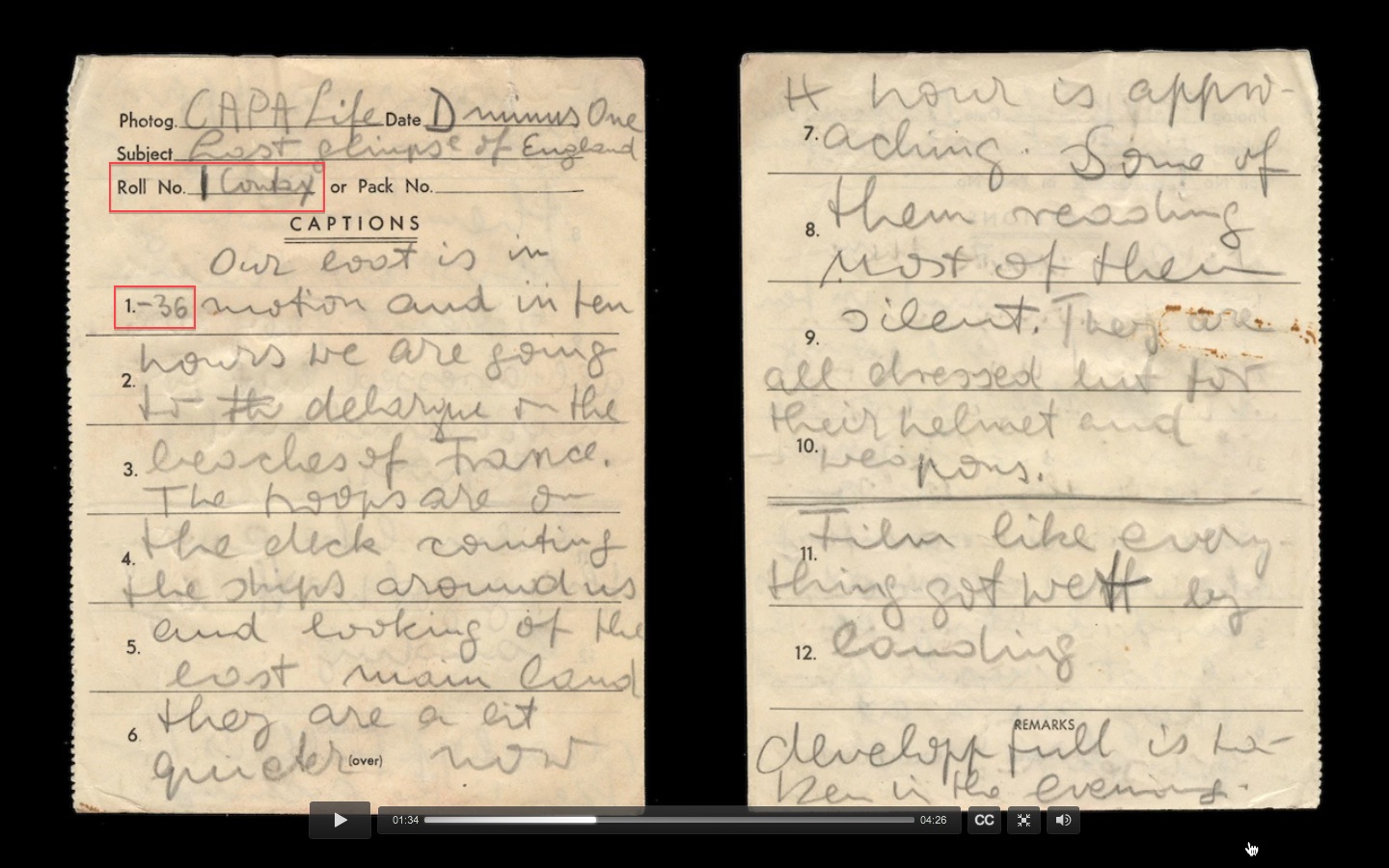
Robert Capa, D-Day image captions, Contax 35mm Roll 2, annotated.
Roll 3 held images of the soldiers resting, reading, playing cards and craps, and otherwise occupying themselves before the battle. Capa gives a breakdown of what’s on the film, and also states that this roll (all his already exposed film?) got wet during the landing. He also gives darkroom instructions: “Developp [sic] full is taken in the evening.”
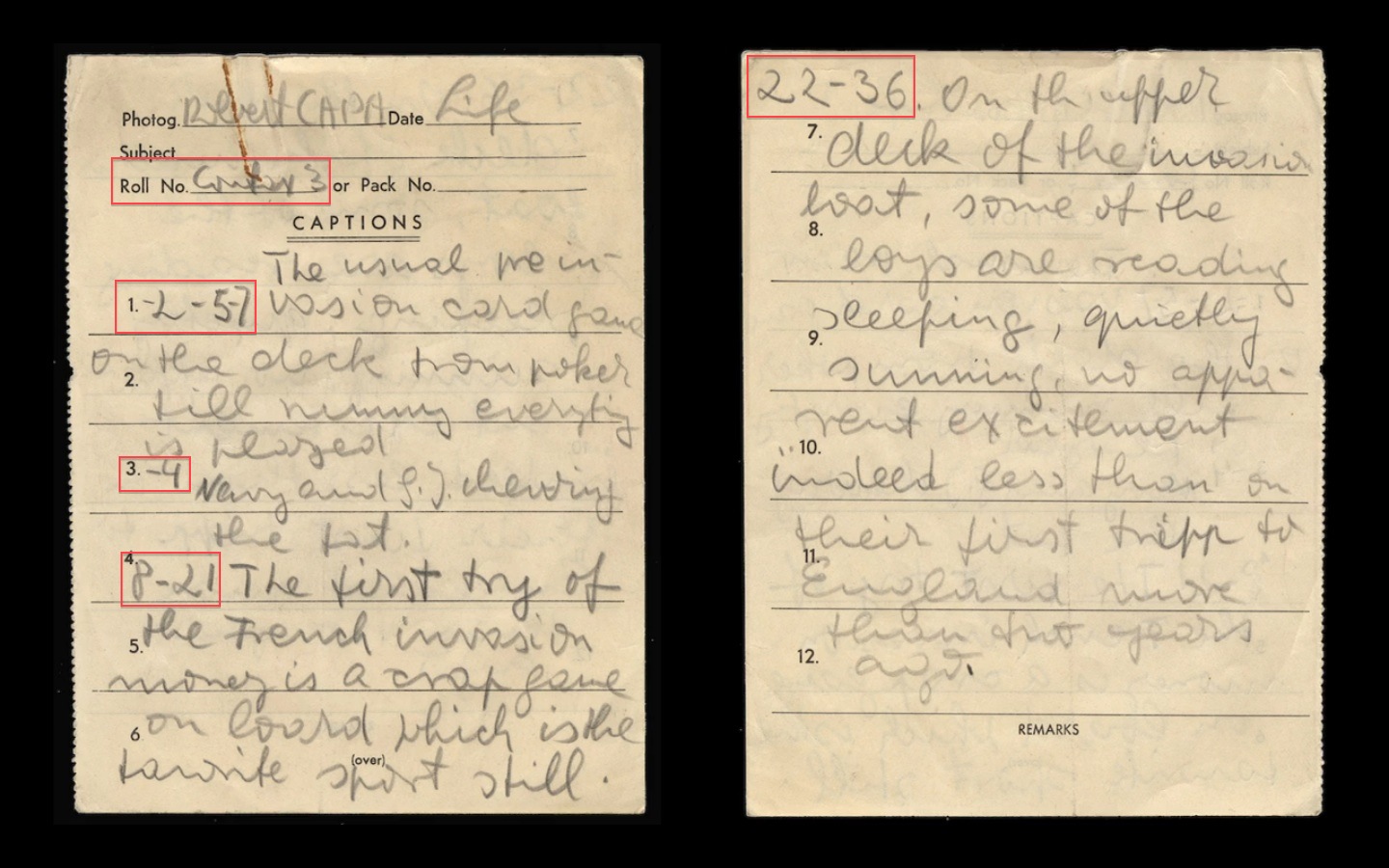
Robert Capa, D-Day image captions, Contax 35mm Roll 3, annotated.
Nothing on this roll of film survived, perhaps due to water damage. If they identified it in London as water-damaged, then possibly they developed it separately, to prevent contaminated the other films with salt water. Nothing on Roll 1 or Roll 2 survived either.
But these images, though historic in the sense that they got made on an historic occasion, were clearly of the “hurry up and wait” human-interest genre that constituted, then as now, a stock-in-trade of combat photographers everywhere: soldiers hanging out, writing the letter home, joining the poker game, etc. Capa made them not under fire, wading through water, or dealing with other difficult situations, but in what most photojournalists would consider ideal circumstances: no pressure, no imminent danger, a clean and dry environment, full access, willing subjects.
Here’s the truly important point: Nothing on these three rolls depicts the actual battlefield, from which the troops and Capa are all still hours away.
•

Marie Brenner, quote from “Robert Capa’s Longest Day,” Vanity Fair, June 2014.
Now, excuse my math (never a strong point): If Capa sent John Morris four (4) rolls of 35mm film, informing him that “the action was all in the 35-millimeter,” then that leaves just one (1) roll actually exposed during the landing and on Omaha Beach. On what basis, then, has anyone ever concluded that Capa made 106 exposures there that day? Capa’s own notes give the lie to this narrative.
That fourth roll would be the one containing the ten (10) images that have become famous as (excuse their math) the “Magnificent Eleven.”
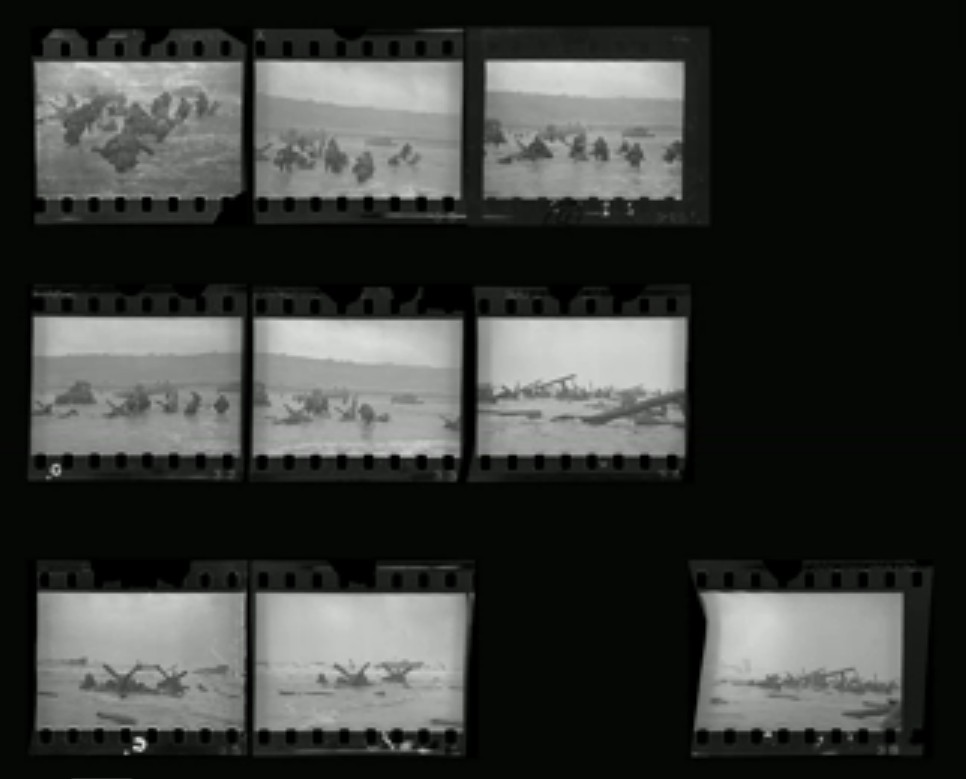
Robert Capa, D-Day frames from 6 June 1944. Courtesy Wikimedia Commons.
According to his own account in his 1947 memoir Slightly Out of Focus, Capa began making pictures with one of the two Contax II 35mm cameras he carried as soon as he got to Omaha Beach, while still on the landing craft, around 6:30 a.m. on June 6, 1944. I would therefore incline to think that they came at the beginning of a roll of film.
Yes, I see that the negative numbers on those frames are high, suggesting that they came at the end of a roll. But I consider it likely that Capa used Super-X film bulk-loaded into Contax cassettes, as did many pros; the manual for the Contax II promises that “[W]hen using [the Contax spool] a film jam is absolutely impossible provided that it has been inserted correctly in the camera.” Bulk-loading can easily result in negative numbers not matching an image’s position on a given roll of film.*
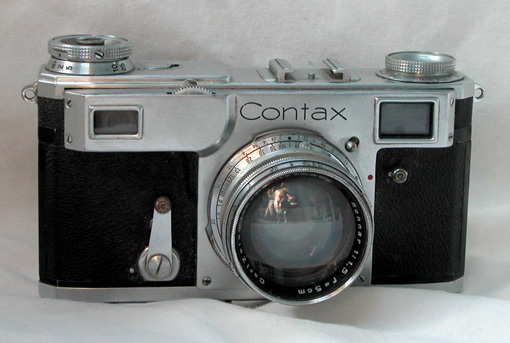
Contax II 35mm rangefinder camera with Carl Zeiss Jena 5 cm f/1.5 high-speed lens.
Though references abound to eleven surviving negatives, I’ve laid eyes on only ten of Capa’s D-Day images, nine of which appear in sequence on the contact sheet above. The blank space in the bottom row of the above contact sheet represents frame 37, the most famous of Capa’s successful exposures, a single exposure of a wounded Private First Class Huston Riley, 16th Regiment, 2nd Battalion, Company F, in neck-high water. This is followed by another image, similar to frame 36, taken from the shallows.
The lone negative of Riley vanished mysteriously shortly after publication in LIFE. Another negative, reportedly too compromised technically to merit publication, went missing as well.
In Slightly Out of Focus, Capa tells us that, after he made his final exposure on Omaha Beach (conceivably frame 38), “my camera jammed — the roll was finished.” (To see all of Capa’s D-Day images at the Magnum website, click here.)
In any case, from the moment the landing craft dropped its door until that moment with Riley in his viewfinder this one of Capa’s two 35mm cameras was set correctly, and his exposures with it were successful. Let’s call the camera with which he exposed the “Magnificent Eleven” Contax A. And let’s call that roll of film Roll 4.
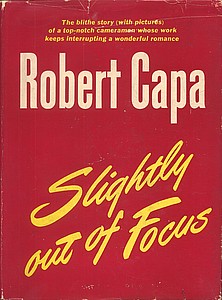
Robert Capa, “Slightly Out of Focus” (1947), cover.
If by then he’d exposed a full roll, the lone Riley image comes close to the end of it and there were 25 exposures preceding the first surviving one of infantrymen entering the water from the landing craft. Presumably those preceding images would have shown the troops inside that boat, and perhaps some views of the approach to the beach. And presumably the blank, drastically overexposed frames shown in the recent video exemplify those preceding exposures.
If I’m right and those images came at the start of the roll, which then did jam (perhaps due to the minor misalignment indicated by the sprocket holes overlapping the exposures), and Capa removed it from the camera, then two-thirds of that roll went entirely unexposed. After development, that unexposed section would have had all its silver halides removed by the fixer, leaving only clear emulsion on the acetate backing. Otherwise, the blank, drastically overexposed frames shown in the video exemplify those subsequent exposures.**
In short, despite the claims by John Morris, Robert Capa, and others that he made 106 exposures at Omaha Beach on June 6, 1944, the actual evidence — the negatives themselves, and Capa’s own caption notes — verifies that he exposed only one roll there before running away, making a maximum of 36 exposures, of which only 11 were successful and survived. The rest of his D-Day take constituted nothing more than pre-battle stock shots with negligible historic value, generically replicated by every photographer on every ship heading to Normandy that night.
(For an index of links to all posts in this series, click here.)
•
* Note: Due in part to long exchanges with photographer Mike Doukas, I’ve since concluded that this constitutes a roll of commercially packaged 36-exposure Super X, or possibly Super XX, and that frame 38 represents the final exposure thereon. Had there been any subsequent ones, a fragment thereof would be visible in the blank area following frame 38. — A. D. C., 6/24/14
** Note: Subsequent research by Rob McElroy revealed that all supposed examples of Capa’s “damaged” D-Day negatives published in the May 29, 2014 TIME video, referred to above, were forgeries produced by Magnum in collusion with the International Center of Photography. While this renders irrelevant the above analysis of those frames, it does not undermine my broader challenge to the “melted emulsion” narrative. — A. D. C.
•
John Morris will participate in a conversation with Robert Pledge, founder and director of Contact Press Images, at the International Center of Photography on June 24, 2014. They’ll stream it, so you can watch it live online at www.icp.org/live. Clicking on that link will enable you to submit a question in advance.
Alternate History: Robert Capa on D-Day (4)
On the Beach
As I continue in my effort to sort fact from fiction in the received versions of the production of Robert Capa’s D-Day images and their post-exposure fate, I have to conclude that we have no hard evidence that Capa made any exposures after the last of the “Magnificent Eleven” — the eleven frames that survived. And nothing proves that Capa stayed on the beach under fire and photographing for more than 40 minutes at most. (To see all of Capa’s D-Day images at the Magnum website, click here.)
Capa’s caption notes to John Morris re the films he sent to him via courier on the evening of June 6, after Capa’s return from Omaha Beach, indicate that three of the four 35mm rolls contained images he made on shipboard on the night of June 5 and the early hours of June 6. These notes appear — published for the first time, so far as I know — in “Behind the Photo: Robert Capa’s D-Day,” a brief TIME video from May 29, 2014. (My thanks to reader Mike Doukas for providing these screenshots of them, which I’ve annotated to highlight Capa’s indication that they’re 36-exposure 35mm films.)
Roll 1 consisted of images of the troops (made from the dock, from the deck, or both) of the troops boarding with their full packs and weapons:
Robert Capa, D-Day image captions, Contax 35mm Roll 1, annotated.
Roll 2 contained images of the troops on deck, observing and counting the other vessles in the vast armada of which they were part, quietly interacting with each other, with their helmets and weapons (and presumably, packs) set aside:
Robert Capa, D-Day image captions, Contax 35mm Roll 2, annotated.
Roll 3 held images of the soldiers resting, reading, playing cards and craps, and otherwise occupying themselves before the battle. Capa gives a breakdown of what’s on the film, and also states that this roll (all his already exposed film?) got wet during the landing. He also gives darkroom instructions: “Developp [sic] full is taken in the evening.”
Robert Capa, D-Day image captions, Contax 35mm Roll 3, annotated.
Nothing on this roll of film survived, perhaps due to water damage. If they identified it in London as water-damaged, then possibly they developed it separately, to prevent contaminated the other films with salt water. Nothing on Roll 1 or Roll 2 survived either.
But these images, though historic in the sense that they got made on an historic occasion, were clearly of the “hurry up and wait” human-interest genre that constituted, then as now, a stock-in-trade of combat photographers everywhere: soldiers hanging out, writing the letter home, joining the poker game, etc. Capa made them not under fire, wading through water, or dealing with other difficult situations, but in what most photojournalists would consider ideal circumstances: no pressure, no imminent danger, a clean and dry environment, full access, willing subjects.
Here’s the truly important point: Nothing on these three rolls depicts the actual battlefield, from which the troops and Capa are all still hours away.
•
Marie Brenner, quote from “Robert Capa’s Longest Day,” Vanity Fair, June 2014.
Now, excuse my math (never a strong point): If Capa sent John Morris four (4) rolls of 35mm film, informing him that “the action was all in the 35-millimeter,” then that leaves just one (1) roll actually exposed during the landing and on Omaha Beach. On what basis, then, has anyone ever concluded that Capa made 106 exposures there that day? Capa’s own notes give the lie to this narrative.
That fourth roll would be the one containing the ten (10) images that have become famous as (excuse their math) the “Magnificent Eleven.”
Robert Capa, D-Day frames from 6 June 1944. Courtesy Wikimedia Commons.
According to his own account in his 1947 memoir Slightly Out of Focus, Capa began making pictures with one of the two Contax II 35mm cameras he carried as soon as he got to Omaha Beach, while still on the landing craft, around 6:30 a.m. on June 6, 1944. I would therefore incline to think that they came at the beginning of a roll of film.
Yes, I see that the negative numbers on those frames are high, suggesting that they came at the end of a roll. But I consider it likely that Capa used Super-X film bulk-loaded into Contax cassettes, as did many pros; the manual for the Contax II promises that “[W]hen using [the Contax spool] a film jam is absolutely impossible provided that it has been inserted correctly in the camera.” Bulk-loading can easily result in negative numbers not matching an image’s position on a given roll of film.*
Contax II 35mm rangefinder camera with Carl Zeiss Jena 5 cm f/1.5 high-speed lens.
Though references abound to eleven surviving negatives, I’ve laid eyes on only ten of Capa’s D-Day images, nine of which appear in sequence on the contact sheet above. The blank space in the bottom row of the above contact sheet represents frame 37, the most famous of Capa’s successful exposures, a single exposure of a wounded Private First Class Huston Riley, 16th Regiment, 2nd Battalion, Company F, in neck-high water. This is followed by another image, similar to frame 36, taken from the shallows.
The lone negative of Riley vanished mysteriously shortly after publication in LIFE. Another negative, reportedly too compromised technically to merit publication, went missing as well.
In Slightly Out of Focus, Capa tells us that, after he made his final exposure on Omaha Beach (conceivably frame 38), “my camera jammed — the roll was finished.” (To see all of Capa’s D-Day images at the Magnum website, click here.)
In any case, from the moment the landing craft dropped its door until that moment with Riley in his viewfinder this one of Capa’s two 35mm cameras was set correctly, and his exposures with it were successful. Let’s call the camera with which he exposed the “Magnificent Eleven” Contax A. And let’s call that roll of film Roll 4.
Robert Capa, “Slightly Out of Focus” (1947), cover.
If by then he’d exposed a full roll, the lone Riley image comes close to the end of it and there were 25 exposures preceding the first surviving one of infantrymen entering the water from the landing craft. Presumably those preceding images would have shown the troops inside that boat, and perhaps some views of the approach to the beach. And presumably the blank, drastically overexposed frames shown in the recent video exemplify those preceding exposures.
If I’m right and those images came at the start of the roll, which then did jam (perhaps due to the minor misalignment indicated by the sprocket holes overlapping the exposures), and Capa removed it from the camera, then two-thirds of that roll went entirely unexposed. After development, that unexposed section would have had all its silver halides removed by the fixer, leaving only clear emulsion on the acetate backing. Otherwise, the blank, drastically overexposed frames shown in the video exemplify those subsequent exposures.**
In short, despite the claims by John Morris, Robert Capa, and others that he made 106 exposures at Omaha Beach on June 6, 1944, the actual evidence — the negatives themselves, and Capa’s own caption notes — verifies that he exposed only one roll there before running away, making a maximum of 36 exposures, of which only 11 were successful and survived. The rest of his D-Day take constituted nothing more than pre-battle stock shots with negligible historic value, generically replicated by every photographer on every ship heading to Normandy that night.
(For an index of links to all posts in this series, click here.)
•
* Note: Due in part to long exchanges with photographer Mike Doukas, I’ve since concluded that this constitutes a roll of commercially packaged 36-exposure Super X, or possibly Super XX, and that frame 38 represents the final exposure thereon. Had there been any subsequent ones, a fragment thereof would be visible in the blank area following frame 38. — A. D. C., 6/24/14
** Note: Subsequent research by Rob McElroy revealed that all supposed examples of Capa’s “damaged” D-Day negatives published in the May 29, 2014 TIME video, referred to above, were forgeries produced by Magnum in collusion with the International Center of Photography. While this renders irrelevant the above analysis of those frames, it does not undermine my broader challenge to the “melted emulsion” narrative. — A. D. C.
•
John Morris will participate in a conversation with Robert Pledge, founder and director of Contact Press Images, at the International Center of Photography on June 24, 2014. They’ll stream it, so you can watch it live online at www.icp.org/live. Clicking on that link will enable you to submit a question in advance.